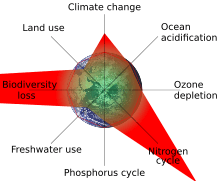Overshoot (population)
In population dynamics and population ecology, overshoot occurs when a population temporarily exceeds the long term carrying capacity of its environment. The consequence of overshoot is called a collapse, a crash or a die-off in which there is a decline in population density. The entire sequence or trajectory undergone by the population and its environment is often termed 'overshoot-and-collapse'.
Overshoot can occur due to lag effects. Reproduction rates may remain high relative to the death rate.[1] Entire ecosystems may be severely affected and sometimes reduced to less-complex states due to prolonged overshoot.[2] The eradication of disease can trigger overshoot when a population suddenly exceeds the land's carrying capacity. An example of this occurred on the Horn of Africa when smallpox was eliminated. A region that had supported around 1 million pastoralists for centuries was suddenly expected to support 14 million people. The result was overgrazing, which led to soil erosion.[3]
Humans
An attempt to apply this concept to human experience is Overshoot: The Ecological Basis of Revolutionary Change, by William R. Catton, Jr.,[4] which updates the 1974 book, The Limits to Growth. The Club of Rome study The Limits to Growth used a computer model which was based on overshoot and collapse.[5] The Limits to Growth simulation showed in several scenarios how overshoot could happen based on an assumption of hard limits to resources, but did not deal with questions of substitution of limited resources with renewable resources.
Depending on your world view, some believe, including Catton, that the Earth's population has already overshot its carrying capacity, by both overpopulation and overconsumption.[6][7] This may include doomers and those within various degrowth movements. An alternative view is cornucopian including those who believe matter and energy will be obtained from beyond Earth.
Measuring human overshoot
Globally, we can measure how much the human economy demands against what the biosphere can renew.[8] One accounting approach is the ecological footprint. Footprint accounting measures the demand on biocapacity, i.e., area of biologically productive land and water required to produce the ecological services (including resource regeneration and waste absorption) for a given population. Biocapacity encompasses the biologically productive capacity of all of the planet's surface areas – cropland, grazing land, forest, fresh water etc. Footprint accounts include non-renewable resources like fossil fuels and other minerals in as far as their use puts a demand on biocapacity. Some demands are difficult to measure and are not included in the accounts – hence the results tend to underestimate dependency. Ecological footprint and biocapacity are measured in global hectares (hectares with world average biological productivity). Thus increased productivity would reduce dependency; while increased population or consumption per head would increase it.
The percentage of an area's footprint supported from its renewable resources shows its overall resource dependence within or above its areas' regeneration rate. A percentage over 100 percent indicates local overuse or net dependence on ecosystems elsewhere. Similarly, the percentage of an area’s population supported from its renewable resources is its sustainable population at current consumption levels with current technology; the remaining percentage is its overshoot population. A country's biocapacity deficit increases as either their population or their per capita consumption grows; and faster if both grow.
Overshoot Index of various countries
A detailed list of countries and their main figures to compute the Overshoot (overpopulation) index has been computed by The Optimum Population Trust. All source data is from The Ecological Footprint Atlas 2010, based on 2007 figures, produced by the Global Footprint Network.[9] Countries with populations of under one million have been omitted. Global Footprint Network’s data are largely from UN sources; their methodology[10] is still admittedly imprecise, but is subject to continuous refinement. [11]
See also
References
- ↑ Schmitz, Oswald J. (2013). Ecology and Ecosystem Conservation. Island Press. p. 51. ISBN 1597265985. Retrieved 2 August 2016.
- ↑ Howes, Michael (2011). "Development and Ethical Sustainability". In Newman, Julie. Green Ethics and Philosophy: An A-to-Z Guide Volume 8 of The SAGE Reference Series on Green Society: Toward a Sustainable Future-Series Editor: Paul Robbins. SAGE Publications. p. 114. ISBN 1452266220. Retrieved 2 August 2016.
- ↑ Debora MacKenzie (10 October 2011). "Low-key projects keep Horn of Africa famine at bay". NewScientist. Reed Business Information. Retrieved 11 October 2011.
- ↑ Meadows, Donella; Jørgen Randers, & Dennis Meadows (2004). Limits to growth: The 30-year update. White River Junction, VT: Chelsea Green Publishing Company. p. 337. ISBN 1-931498-51-2.
- ↑ Sharpe, M.E. (2015). Economic Abundance: An Introduction. M.E. Sharpe,. p. 67. ISBN 0765628082. Retrieved 2 August 2016.
- ↑ Ryerson, W. F. (2010), "Population, The Multiplier of Everything Else", in McKibben, D, The Post Carbon Reader: Managing the 21st Centery Sustainability Crisis, Watershed Media, ISBN 978-0-9709500-6-2
- ↑ Brown, L. R. (2011). World on the Edge. Earth Policy Institute. Norton. ISBN 978-0-393-08029-2.
- ↑ Mathis Wackernagel, Niels B. Schulz, Diana Deumling, Alejandro Callejas Linares, Martin Jenkins, Valerie Kapos, Chad Monfreda, Jonathan Loh, Norman Myers Richard Norgaard and Jørgen Rander (May 16, 2002). Tracking the ecological overshoot of the human economy. Retrieved 2 August 2016.
- ↑ Global Footprint Network. Retrieved 6 August 2016.
- ↑ Methodology and Sources. Global Footprint Network. Retrieved 6 August 2016.
- ↑ Optimum Population Trust (10 April 2012). "New index highlights most overpopulated countries". Overshoot Index. Optimum Population Trust. Retrieved 10 April 2012.

